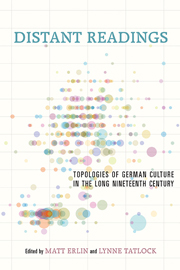Book contents
- Frontmatter
- Contents
- Acknowledgments
- Introduction: “Distant Reading” and the Historiography of Nineteenth-Century German Literature
- I Quantification
- II Circulation
- 6 The Werther Effect I: Goethe, Objecthood, and the Handling of Knowledge
- 7 Rethinking Nonfiction: Distant Reading the Nineteenth-Century Science-Literature Divide
- 8 Distant Reception: Bringing German Books to America
- 9 The One and the Many: The Old Mam'selle's Secret and the American Traffic in German Fiction (1868–1917)
- III Contextualization
- Selected Bibliography
- Contributors
- Index
8 - Distant Reception: Bringing German Books to America
from II - Circulation
Published online by Cambridge University Press: 05 April 2014
- Frontmatter
- Contents
- Acknowledgments
- Introduction: “Distant Reading” and the Historiography of Nineteenth-Century German Literature
- I Quantification
- II Circulation
- 6 The Werther Effect I: Goethe, Objecthood, and the Handling of Knowledge
- 7 Rethinking Nonfiction: Distant Reading the Nineteenth-Century Science-Literature Divide
- 8 Distant Reception: Bringing German Books to America
- 9 The One and the Many: The Old Mam'selle's Secret and the American Traffic in German Fiction (1868–1917)
- III Contextualization
- Selected Bibliography
- Contributors
- Index
Summary
Statistics do not tell a story by themselves, of course, but they can open the way to various narratives by revealing patterns.
Robert Darnton, “Book Production in British India, 1850–1900”Cultures rarely operate in isolation. They are in contact with impulses from many directions and in many ways. But what do we know about how this happens? How can we assess the significance and processes of the transfer between cultures? I am particularly interested in German-American cultural exchange in the first third of the nineteenth century, before the waves of German immigrants came to the United States, because this encounter was launched and sustained mostly by Americans who had no German ancestry. Their lack of German experience or knowledge of the German language raises the question of what German culture had to offer these Americans and their young republic. What were they looking to find in Germany, and what did they bring back?
Interest in this period is not new. For over a century, scholars have examined the migration of German culture to America prior to 1830. Already around 1900 both a new journal and a book series entitled Americana Germanica began publishing investigations about the first introduction of German literature to North America. In the subsequent five decades, scholars such as A. B. Faust and Henry A. Pochmann presented detailed accounts of the early importation of German culture to the United States as well as the impact of later millions of German immigrants on American culture. More recently and within the framework of cultural transfer, contemporary scholars have examined a broader range of contact between Germany and the United States.
- Type
- Chapter
- Information
- Distant ReadingsTopologies of German Culture in the Long Nineteenth Century, pp. 209 - 228Publisher: Boydell & BrewerPrint publication year: 2014



